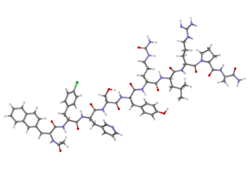 | |
 | |
| Clinical data | |
|---|---|
| Trade names | Cetrotide, others |
| AHFS/Drugs.com | Monograph |
| Routes of administration | Subcutaneous injection |
| Drug class | GnRH analogue; GnRH antagonist; Antigonadotropin |
| ATC code | |
| Legal status | |
| Legal status |
|
| Pharmacokinetic data | |
| Bioavailability | 85% |
| Protein binding | 86% |
| Elimination half-life | 62.8 hours / 3 mg single dose; 5 hours / 0.25 mg single dose; 20.6 hours / 0.25 mg multiple doses |
| Excretion | feces (5% to 10% as unchanged drug and metabolites); urine (2% to 4% as unchanged drug) |
| Identifiers | |
| |
| CAS Number | |
| PubChem CID | |
| IUPHAR/BPS | |
| DrugBank | |
| ChemSpider | |
| UNII | |
| KEGG | |
| ChEBI | |
| ChEMBL | |
| CompTox Dashboard (EPA) | |
| ECHA InfoCard | 100.212.148 |
| Chemical and physical data | |
| Formula | C70H92ClN17O14 |
| Molar mass | 1431.06 g·mol−1 |
| 3D model (JSmol) | |
| |
| |
| | |
Cetrorelix (INN, BAN), or cetrorelix acetate (USAN, JAN), sold under the brand name Cetrotide, is an injectable gonadotropin-releasing hormone (GnRH) antagonist. A synthetic decapeptide, it is used in assisted reproduction to inhibit premature luteinizing hormone surges[1] The drug works by blocking the action of GnRH upon the pituitary, thus rapidly suppressing the production and action of luteinizing hormone (LH) and follicle-stimulating hormone (FSH). In addition, cetrorelix can be used to treat hormone-sensitive cancers of the prostate[citation needed] and breast (in pre-/perimenopausal women)[citation needed] and some benign gynaecological disorders (endometriosis, uterine fibroids and endometrial thinning).[citation needed] It is administered as either multiple 0.25 mg daily subcutaneous injections or as a single-dose 3 mg subcutaneous injection. The duration of the 3 mg single dose is four days; if human chorionic gonadotropin (hCG) is not administered within four days, a daily 0.25 mg dose is started and continued until hCG is administered.
It is available as a generic medication.[2][3]
- ^ "Cetrotide 0.25 mg" (PDF). emdserono.com. Archived from the original (PDF) on 5 April 2016. Retrieved 30 January 2016.
- ^ "2022 First Generic Drug Approvals". U.S. Food and Drug Administration (FDA). 3 March 2023. Archived from the original on 30 June 2023. Retrieved 30 June 2023.
- ^ "Competitive Generic Therapy Approvals". U.S. Food and Drug Administration (FDA). 29 June 2023. Archived from the original on 29 June 2023. Retrieved 29 June 2023.